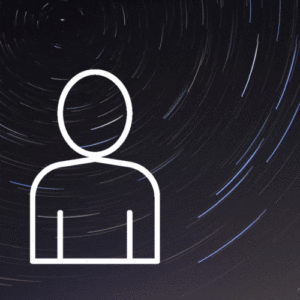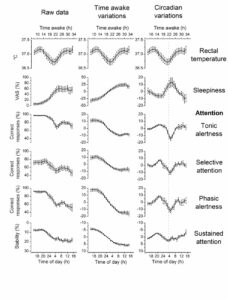
Turns out that there might be times of the day that are better in terms of being able to pay attention and concentrate. Take a guess on when they are before reading the article.
What if someone could tell you the best times of the day to work or study. That would be useful huh?
Turns out that person might be Pablo Valdez who published a paper in 2019 in the Yale Journal of Biology and Medicine called Circadian Rhythms in Attention.
Spoiler – “according to data reviewed in this paper, healthy individuals show acceptable levels of cognitive performance from 10am to 2pm and 4pm to 10pm“. That seems pretty simple. Do your study at these times if you want to align best with your circadian rhythms. 
If you are curious to know more, read on. Otherwise, change your diary 🙂 [note: it is a little more complex than simply picking those two times]
Valdez arrived at this conclusion by reviewing papers that explored different types of attention and how they fluctuated over 24-hour cycles in response to our biological rhythms.
Our circadian rhythm is one of the best-known biological rhythms. It works over a 24-hour period, synchronized to light, temperature, feeding and social stimulation. Our circadian rhythm drives oscillations in all sorts of bodily processes – temperature, cortisol, melatonin, motor activity, cardiac, pulmonary, metabolic, nervous system, hormones, and sleep-wake cycles. People often hear about it in the context of sleep. But there can be many health reasons to try and regulate one’s circadian rhythm.
But what Valdez wanted to know was whether our capacity to pay attention moves in accordance with circadian oscillations and if so, whether a knowledge of how attention shifts over time might improve recommendations for when to work and study. We know that there are oscillations in various performance metrics: sensory, motor, reaction time, time estimation, memory, verbal, arithmetic, simulated driving. But are these following biological rhythms?
Let’s start with what we mean by attention
Attention is the capacity to interact effectively with your environment – processing and selecting what incoming stimuli to focus on. When you are studying, you need to be paying attention to your studies. When you are with a friend, you need to pay attention to them (assuming you like them 😆). I’m sure you’ve experienced times when you were able to focus your attention and be immersed in an activity. Similarly, I’m sure you’ve experienced times when you found it very difficult to concentrate and kept getting distracted. Attention is critical in the performance of all human activities.
Valdez described 4 types of attention: tonic, phasic, selective, and sustained. Tonic is our baseline level of attention and ability to respond to any event in our environment. It is a measure of our general arousal and activation. Phasic is our capacity to respond after a warning signal of some kind. It is about being primed ready and able to respond to specific challenges. Selective attention is the ability to generate a specific response to a specific stimulus and filter out irrelevant stimuli. Sustained attention is the ability to continue to respond to a specific stimulus over an extended period of time. A good study or work session needs multiple forms of attention. For example, you need a general level of attention to get started, the ability to focus on specific tasks, filter out distractions, and sustain your attention over time.

The attention studies that Valdez reviewed are complex and fascinating. Studying variation in people’s capacity to pay attention in everyday life is difficult because of all the varied factors that influence attention (light, sleep, food, other activities, environment, distractions etc). To isolate circadian fluctuations in attention, researchers put people in highly controlled conditions (i.e. laboratories), reduce or control as many of those variables as possible and measure their attention multiple times throughout the day. Sometimes they even create different day lengths (e.g. 28 hours) so they can study circadian rhythms at times when the person would normally be asleep (note: the body continues to operate on a 24-hour cycle hence why this is possible).
So, what do we observe?
Some observations are common sense. For example, the longer we are awake and hence the sleepier we get, our ability to pay attention decreases. Unlikely to blow your mind.
 But within that bigger cycle are more nuanced oscillations, those referred to at the beginning of this post. Namely that the 4 components of attention show peaks and troughs at different times of the day, generally in synchrony with circadian markers like body temperature and sleepiness. For example, attention appears to move in a delayed synch with body temperature and in a reverse synch with sleepiness.
But within that bigger cycle are more nuanced oscillations, those referred to at the beginning of this post. Namely that the 4 components of attention show peaks and troughs at different times of the day, generally in synchrony with circadian markers like body temperature and sleepiness. For example, attention appears to move in a delayed synch with body temperature and in a reverse synch with sleepiness.
In short, peak attention times seem to be 10am to 2pm and 4pm to 10pm. Those intervals seem to also correspond with variation in other cognitive processes like working memory and executive function, meaning these appear to be meaningful times of the day when it comes to engaging in mental tasks such as study. Very early or very late times of the day are the worst for attention.
To be clear, these are data-estimated best times for capacity to pay attention, in a healthy person with a fairly normal schedule. In everyday life, all sorts of things will affect attention: schedules, sleep routines, when we eat, when we exercise, where we work, environment, weather, active netflix subscription etc.
Valdez wrote about 4 factors that might influence these intervals. The first was chronotype, which is a person’s preferences for when in the day to work. I am a morning chronotype meaning my preference for work is that first interval (10am to 2pm). Many university students I suspect are evening types and would find the second interval (4pm to 10pm) preferable.
The second was sleep deprivation which tends to deteriorate performance at any time of the day.
Age was the third factor with adolescents and younger adults more likely to have delayed sleep cycles and hence prefer the evening time. Aged adults (which I think of myself as 🍷 🧀) tend to have advanced (forward) sleep-cycles and prefer the morning times. This might explain why I want to run workshops in the morning, but many student participants would prefer an afternoon or evening time.
The final factor was drug use, particularly caffeine, which can be used to advance or delay one’s circadian cycle. Thus, caffeine in the morning may preference the early interval. Caffeine in the afternoon may preference the later interval.
What might this mean for you and your productivity?
This work suggests there are times of the day where attention, focus and concentration are better aligned with our natural biological rhythms. A starting point might be to see if you can alter your schedules to fit these and see if it produces positive outcomes.
You might be able to support work at these times by shifting other things such as your sleep schedule, caffeine use, food intake, and exercise patterns. For example, exercising in the morning and delaying my caffeine (tea) intake until 9am has helped me take better advantage of the first interval.
Note your preferences for when in the day to study/work and see if you can utilise that time of the day for the most important and challenging tasks, leaving the other interval for more mundane work.
Basically, experiment a bit with how you structure your days, with these intervals in mind, to see if it produces any meaningful improvements in your productivity.
A note of caution though. It is easy to read this kind of work and get obsessed with organising one’s day according to these recommendations. In practice, there are many demands on us in each day (work, study, social etc), so don’t burn yourself out trying to fit the day to this schedule if it doesn’t fit. This is just one piece of a bigger puzzle about how to build rewarding, satisfying and productive days.


